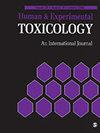食用麦角生物碱会改变血清素受体诱导的绵羊脐血管活性
IF 3.2
4区 医学
Q3 TOXICOLOGY
引用次数: 0
摘要
研究表明,在妊娠后半期服用麦角生物碱会降低脐动脉血管活性,导致出生体重下降。麦角生物碱对血管的负面影响主要是通过其他组织中的血清素能和肾上腺素能受体介导的。在妊娠 d-110 和 d-133 天时,对接受内生菌感染种子(E + 1.77 mg 麦角碱/hd/d)或总混合饲料对照(CON;0 mg 麦角碱/hd/d)高羊茅种子的母羊的脐动脉和静脉中血清素(5-HT)受体 5-HT2A 和 5-HT1B/1D 的血管活性进行了评估。从母羊身上采集妊娠生殖道。将两毫米的脐动脉和静脉切片暴露于浓度不断增加的 5-HT1B/1D 激动剂和 5-HT2A 激动剂中。5-HT1B/1D 激动剂不会刺激动脉或静脉或任何一个妊娠时间点的收缩反应。5-HT2A 激动剂在动脉中引起了较大的反应,最大的反应发生在妊娠第 110 天,随着妊娠天数的增加,反应幅度逐渐减小(p <0.05)。在妊娠第 110 天和第 133 天,来自 CON 母羊的动脉比来自 E+ 母羊的动脉有更大的收缩反应(p < 0.05)。静脉对浓度不断增加的 5-HT2A 激动剂有反应。当暴露于 5-HT2A 激动剂时,d-110 静脉的最大反应大于 d-133(p < 0.05)。与动脉不同,E+母羊静脉的 d-133 收缩反应大于 CON(p < 0.05)。脐动脉和静脉的血管收缩是由 5-HT2A 受体活性而非 5-HT1B/1D 引起的。脐动脉 5-HT2A 受体活性对种子处理更敏感,可能是麦角生物碱诱导宫内生长受限的原因。本文章由计算机程序翻译,如有差异,请以英文原文为准。
Ergot alkaloid consumption alters serotonin receptor-induced vasoactivity in ovine umbilical vasculature
Consumption of ergot alkaloids during the second half of gestation has been shown to decrease umbilical artery vasoactivity resulting in decreased birth weights. Negative vascular effects of ergot alkaloids are mediated predominantly through serotonergic and adrenergic receptors in other tissues. Vasoactivity of serotonin (5-HT) receptors 5-HT2A and 5-HT1B/1D in umbilical artery and vein from ewes receiving endophyte-infected seed (E + 1.77 mg ergovaline/hd/d) or a control total mixed ration (CON; 0 mg ergovaline/hd/d) tall fescue seed at d-110 and d-133 of gestation was evaluated. Gravid reproduction tracts were collected from ewes. Two-mm sections of umbilical artery and vein were exposed to increasing concentrations of a 5-HT1B/1D agonist and 5-HT2A agonist. The 5-HT1B/1D agonist did not stimulate a contractile response in artery or vein or either gestation time point. 5-HT2A agonist caused large responses in artery with greatest occurring at d-110 and decreasing in magnitude as days of gestation increased ( p < 0.05). On d-110 and 133 of gestation, arteries from CON ewes had greater contractile response than arteries collected from E+ ewes ( p < 0.05). Veins responded to increasing concentrations of the 5-HT2A agonist. Maximal d-110 vein response was greater than d-133 when exposed to 5-HT2A agonist ( p < 0.05). Unlike the artery, veins from E+ ewes had greater d-133 contractile response than CON ( p < 0.05). Vascular contractions of umbilical artery and vein are induced by 5-HT2A receptor activity and not 5-HT1B/1D . Umbilical artery 5-HT2A receptor activity was more sensitive to seed treatment and could be responsible for ergot alkaloid-induced intra-uterine growth restriction.
求助全文
通过发布文献求助,成功后即可免费获取论文全文。
去求助
来源期刊
CiteScore
5.70
自引率
3.60%
发文量
128
审稿时长
2.3 months
期刊介绍:
Human and Experimental Toxicology (HET), an international peer reviewed journal, is dedicated to publishing preclinical and clinical original research papers and in-depth reviews that comprehensively cover studies of functional, biochemical and structural disorders in toxicology. The principal aim of the HET is to publish timely high impact hypothesis driven scholarly work with an international scope. The journal publishes on: Structural, functional, biochemical, and molecular effects of toxic agents; Studies that address mechanisms/modes of toxicity; Safety evaluation of novel chemical, biotechnologically-derived products, and nanomaterials for human health assessment including statistical and mechanism-based approaches; Novel methods or approaches to research on animal and human tissues (medical and veterinary patients) investigating functional, biochemical and structural disorder; in vitro techniques, particularly those supporting alternative methods

 求助内容:
求助内容: 应助结果提醒方式:
应助结果提醒方式:


